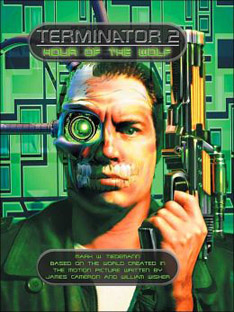Mark W. Tiedemann’s “Hour of the Wolf” (2004) is an oddball novel: It was released in the wake of “Terminator 3” but is part of the “Terminator 2” franchise. And it’s a continuation of Russell Blackford’s young-adult trilogy, yet it’s an adult novel. Probably only the most die-hard “Terminator” fans have read it. It’s worth reading, though.
I haven’t encountered another “Terminator” novel that goes more in-depth in the science of time travel. While fans of the action aspects of the franchise will find “Hour of the Wolf” bland, people who like the nerdier aspects will dig it. And because Tiedemann is writing an adult novel rather than young-adult, we get better characterizations of Blackford’s characters, as well as John and Sarah, although they are somewhat in supporting roles here. A high number of typos work against the book, but I still recommend it, especially if you’ve come this far down the rabbit hole of the Blackford saga.
CHARACTERS
John Connor: To stay under the radar of the cops who still want him for past attacks on Cyberdyne, he goes by the name Sean Philicos. Because John had met his older self in the Blackford trilogy, he had “grown used to thinking of himself as more than one person.” He runs a security firm with his mom.
Sarah Connor: To stay under the radar of the cops who still want her for past attacks on Cyberdyne, she goes by the name of Julia Philicos and poses as John’s older sister.
Jeremiah (Bobby) Porter: A college student who is breaking ground in the field of time travel theory.
Lee Portis: An amnesiac time traveler, he just knows he has to find John, Sarah and Jeremiah Porter. He eventually finds out he is the older version of Jeremiah (Bobby) Porter. He is a Specialist, an enhanced human, like Anton and Jade from the Blackford trilogy.
Jack Reed: The Connors’ friend in the government who was instrumental in minimizing Cyberdyne’s power in 2001.
Oscar Cruz: The nanobot-enhanced human gets out of prison and rejoins Cyberdyne.
Juanita “Jenny” Salceda: She’s the third member of the Connors’ security company in New Mexico, although she drops out of the story after the move to L.A. She is John’s girlfriend in one of the Blackford timelines.
TERMINATORS
Casse: A T-XA model, Casse – who had traveled from the future all the way back to 1982, then observed events through the years – becomes the vice president of Cyberdyne and builds it back up in the wake of the government sanctions that minimized its influence in 2001. His mission is to hire (or kill) potential inventors of time travel in order to secure the “true” future. His role is the same as the T-1000 Catherine Weaver in “The Sarah Connor Chronicles” and the T-1000 in Malibu Comics’ “Cybernetic Dawn.”
Gant: A T-800, model 101. When our heroes defeat Gant, Casse uncrates another T-800 and programs it with the Gant “personality” (similar to “Dollhouse”). Casse describes T-800s as “plodding precursor forms” (p. 238). While T-800s predate Skynet’s sentience here, they have post-dated Skynet’s sentience in other timelines, being created anywhere from 2009 to 2029.

CONTINUITY AND CONTRADICTIONS
“Hour of the Wolf” picks up after the Connors’ wild timeline-hopping adventures in the Blackford trilogy. As the characters are back in the main timeline (John’s World, as Blackford called it), the key past events are the movie events plus the good guys’ attack on Cyberdyne’s Colorado Springs site in 2001.
The time-traveling Lee Portis pops up in 2006, then we catch up with John and Sarah in 2007, running a successful security business that they are transplanting from New Mexico to Los Angeles. On this timeline, this marks the Connors’ first return to L.A. since the events of “T2.”
“Hour of the Wolf” places the events of “Terminator 2” in 1994. As more stories come out, this is becoming the more accepted date of that movie’s events, which are sometimes placed in 1995.
The Terminator (Gant) and other operatives of Casse are killing off people named Jeremiah Porter nationwide. This, of course, is a parallel to the Terminator killing off various Sarah Connors in L.A. in the first film.
Cyberdyne is transferring equipment from Colorado Springs to a newly purchased site at the former L.A. Air Force Base. It needs a larger facility, and this also lines up the continuity with the films’ Future War scenes, where the 2029 events take place in L.A.
When Portis tells Sarah about his future (p. 187), he reveals that “most (cities) are in ruins in the Northern Hemisphere,” which is consistent across all “Terminator” stories.
Portis says Skynet takes total control in 2025, which is a bit later than most stories.
Portis adds that space – particularly the moon and Mars – are being settled by humans, which is rare for a “Terminator” story, but not unprecedented: The Moon had human settlers in 1998 in the Now Comics series.
After 1994, Sarah had gone to ground but rallied anti-Cyberdyne sentiment on the Internet (p. 200). John uses similar methods for recruiting allies in the S.M. Stirling trilogy.
Casse communicates with Skynet via a vaguely defined high-tech mind-reading device (p. 232). The idea of the personification of Skynet has been used in some “Terminator” stories, whereas in others, it is not anthropomorphized. Tiedemann splits the difference.
TIMELINES AND TIME TRAVEL
“Hour of the Wolf” features two instances of time travel, both of which are referenced rather than explicitly shown: Casse had come from the future to 1982 (then observed for several years before taking action), and Portis had come from the future to 2006.
Tiedemann favors the term “frames” when talking about timelines.
The author uses the term “Nexus point” (p. 188) to describe the point at which various possible timelines converge into one. 2029 is a Nexus point in many frames. Time travel is the key to creating multiple frames, and the destruction of all time-travel devices is the key to creating a Nexus point.
Tiedemann surmises the universe will work against a time traveler’s aims to change the timeline he is visiting. Casse, a T-XA, tries to kill Jeremiah Porter, a hapless human, in his office at Cyberdyne, and fails – his blows keep missing by inches. Casse comes to believe it is impossible for an actor from outside the frame to kill someone in that frame. Following this theory, Casse also believes the 1984 T-800 would have failed to kill Sarah even without Reese’s intervention (p. 193). On page 203, Tiedemann writes:
“(Casse) doubted he could (kill the Connors). In the past they had demonstrated a powerful link to the frame, a resistance to interference from any out-of-frame agent. Like younger Porter, they could only be killed by someone native to their own frame.”
Bobby similarly seeks explanations for why Casse’s blows missed him, and he concludes that “fate” is helping him out (p. 209).
As his memory loss clears, Portis realizes he had two options in his aim to secure the future for humanity (p. 282): To kill Bobby or to protect Bobby, whichever seems most prudent. Like Casse, Portis comes to the conclusion that a time-traveling Terminator could not be sent back to kill Bobby, as fate would conspire to stop it. But he believes — correctly, it turns out — he’d be able to kill “himself.”
Portis believes the frame will be overwritten if he kills Bobby (his younger self) and he will cease to exist (p. 268). However, he continues to exist upon killing his younger self. But he wonders if he might yet fade out of existence as time moves forward.
Tiedemann notes that quantum mechanics deals with possible realities, but that generally doesn’t apply to the macro world. The lone exception is time travel, which does indeed deal with the concept of possible futures (p. 270).
John experiences two frames splicing together (p. 279) as he jumps ahead about 10 minutes and sees visions of an alternate event (a building blowing up) interspersed with the reality that he escaped from the building and it is still intact. Another character confirms she also experienced the timeframe-splicing, whereas two other characters say they did not experience it. Will John remember this experience? He notes that “The mind was compensating by offering up explanations,” so perhaps he’ll gradually forget as time goes by. Dark Horse’s “Robocop versus The Terminator” and “Endgame” showed characters directly experiencing the splicing of timelines, but this is the first example of it in novel form.

